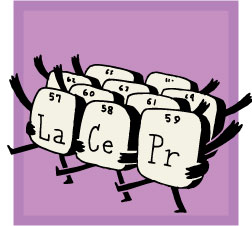Blogging the Periodic Table

If the periodic table was actually a roulette table and people could bet on the element they thought would be the next big thing in energy production, you'd find chips scattered all over the board, in just about every column and row.
But among all the wagers, you'd find some surprisingly handsome stacks along one obscure corridor of elements: the rare earths, the top of the two rows hanging in space beneath the periodic table. Many green energy options rely on these elements, so it's an intriguing bet. Unfortunately, there's just as good a chance that a lack of rare earths could stymie a few eco-friendly technologies before they even get started.
The rare earths start at lanthanum, Element 57, and run to lutetium, Element 71, and if you look them over, there's a good chance you won't recognize any of them. In addition to being anonymous, they're also misnamed. Like the old joke about the Holy Roman Empire, many rare earths are not rare (cerium is as common as copper), nor are they "earths" in the common sense of being "soil." (Earth is an archaic term for minerals that contain oxygen.)
People often ask why rare earths dangle there below the table instead of sitting where their numbers say they should, in Row 6. One reason is practical. Removing them makes the table narrower and less unwieldy to print. But there are good chemistry-based reasons to separate them, too—because they all act like a single element.
Normal elements have certain properties based on how many electrons they make available for other elements to react with. Sodium, Element 11, has one available; magnesium, Element 12, has two; aluminum, Element 13, has three, etc. In other words, each element adds one electron as its number increases, and this addition of an electron makes the element distinct and easy to separate from its neighbors. As you move steps east or west on the periodic table, you typically encounter distinct personalities.
Typically. For reasons that, while not complicated, would require a whole 'nother blog post of background information to explain adequately (I cover it in my book), rare earth elements do something cunning. They conceal their additional electrons in the atomic equivalent of false-bottomed drawers. So when you move from Element 59 to 60 to 61, the same basic number of electrons are exposed in each case.
As a result, it's very, very hard to separate these elements from one another—imagine trying to separate all the spices in your cabinet after they're dumped into one big bowl. In fact, they proved such a pain to work with that they found only limited use in industry.
But in the past few decades, some patient chemists have learned to exploit the subtle differences among rare earth elements to create amazing technology. Neodymium and gadolinium now make unprecedentedly powerful magnets, which can cool and refrigerate things for pennies, replacing nasty, expensive, ozone-killing chemicals. The Toyota Prius uses neodymium in magnets in its motor. * Cerium makes great catalytic converters to clean pollution up, and europium makes energy-efficient LED bulbs. Many superconductors use yttrium, and even simple wind turbines need dysprosium and terbium to store energy, among other things.
All this sounds promising, but rare earths remain quite difficult to get your hands on. China has half of the world's reserves and produces a staggering 95 percent of the ore on the world market. That's because the Chinese government made a shrewd guess in the 1990s and invested in the infrastructure necessary to tediously separate one rare earth from another on an industrial scale.
China's dominance wouldn't be a huge concern except that the government has put strict quotas on exports lately. Some rare earths now fetch more than $100 a pound in the United States. (The U.S. once mined rare earths but let the industry flag and would need about 15 years to catch up.) And again, while not all rare earth elements are scarce, some of the heavier ones are, and green energy industries already struggling to prove their economic viability could be hard-pressed to produce affordable technology if these metals become prohibitively expensive.
Rare earths aren't the only elements we may have to scramble for in the next century. The rare element indium, for instance, significantly boosts the capacity of solar panels, and any attempts to implement solar panels worldwide could expose a serious shortage. (One metals expert recently said, "Scientists should anticipate the possibility that they may not have the whole periodic table to work with in future.") But no element can help out in so many new carbonless technologies as the rare earths. If they get the chance.
Like Slate on Facebook. Follow us on Twitter.
* Correction, July 15, 2010:This article originally stated that the Prius is made by Honda. (Return to the corrected sentence.)
Correction, July 20, 2010: This article originally stated that the Prius uses fuel cells. It does not. (Return to the corrected sentence.)